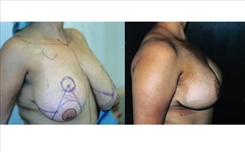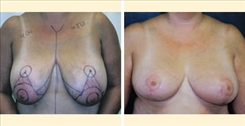

Breast Reduction
Some women develop breasts that are too large for their bodies. Heavy, cumbersome breasts can cause a range of physical and psychological issues, including chronic pain, rashes, and general discomfort. Breast reduction surgery alleviates these concerns by removing excess tissue and skin, reducing the size of the breasts, and restoring them to a more youthful proportion.
During your private consultation, Dr. Linder will evaluate your needs and desires to help determine the best technique to achieve your specific aesthetic goals.
Women choose breast reduction to ease the discomfort and frustration of overly large breasts. Having excess tissue and fat can wreak havoc on physical and emotional comfort and can be aesthetically displeasing. While breast reduction is tailored to the individual, many women turn to this surgery to address at least one of the following:
- Create a more proportionate body frame
- Alleviate breast-related back, neck, shoulder, and chest pain
- Reduce instances of skin rashes around and beneath the breasts
- Restore youthful perkiness (when combined with a lift)
- Minimize unwanted social attention due to large breasts
- Increase ability to wear a wider variety of clothing styles

Ideal Candidates
Some women developed their large breasts early and fast; others saw the unwanted increase after pregnancies or weight fluctuations. Regardless of how long you’ve been unhappy with your large and heavy cleavage, reduction can help. Ideal candidates for this surgery are in good overall health, do not smoke, and have realistic expectations for their results.
Nearly all breast reduction patients will undergo a lift at the same time. This additional technique will further tighten the tissues to restore a lifted and tightened aesthetic.
How Old Do You Have to Be for Breast Reduction?
Many young girls with overly large breasts are eager to undergo the reduction procedure. However, eligible candidates need to have finished developing. This usually happens around 18 years of age.
Schedule a consultation with Dr. Linder to see if you are a candidate for this surgery.
Benefits of Breast Reduction Surgery
Reduces Back and Neck Pain
When breasts are excessively large, their weight puts tension on a woman’s back and neck. The constant strain causes physical discomfort and slouching, which can weaken neck muscles. Breast reduction removes some of the tissue and skin, decreasing the weight of pendulous breasts and enabling patients to lead more active lifestyles.
Eliminates Deep Shoulder Grooves
Since bra shoulder straps bear the bulk of the weight of the breasts, they often dig into a woman’s shoulders, creating uncomfortable grooves. These grooves can even compress the nerves in the area, leading to a wide range of issues, such as coracoid syndrome and ulnar neuropathy. Breast reduction surgery lifts this weight off the shoulders and allows for greater comfort.
Decreases Instances of Skin Irritation
Having overly large breasts increases a woman’s risk of skin irritation. When the skin folds under the breasts rub together, a woman can develop intertriginous dermatitis or ulcers. Breast reduction surgery removes excess tissue to reduce pressure and increase airflow to the chest area, which prevents these rashes and improves patient comfort and mobility.
What Is the Inferior Pedicle (Wise-Pattern) Technique?
This technique achieves smaller, perkier breasts with a decreased risk of nerve damage and skin necrosis. An anchor-shaped incision (around the nipple, vertically down the lower pole, and along the crease) is used to remove excess tissue and skin. Once the excess tissue is removed, the breasts are lifted and reshaped without detaching the nipple-areolar complex from its vascular system. Dr. Linder prefers this method because it allows for drastic reductions in tissue while keeping the nipple and areola attached to the original blood and nerve supply.
What Is the Benelli/Periareolar (Round Block) Technique?
This technique is beneficial for breasts that only require a small reduction. A donut-shaped piece of tissue is removed from around the areola. The remaining skin is lifted and brought together with the edges of the areola, producing firmer, smaller breasts. This technique is less invasive than the Wise-pattern method but does not achieve as drastic results.
What Is the Vertical Scar Technique?
This technique is useful for smaller breast reductions that require skin excisions only from the middle of the breasts and not from the lower pole to achieve the ideal shape. The vertical scar technique, as the name implies, removes excess skin using a vertical incision down the lower portion of the breast.
What Is the Central Mound (L-Short Scar) Technique?
This technique is necessary for patients who require an enormous amount of tissue to be removed and whose nipples and areolas need to be repositioned. Excess breast tissue is removed as needed, and the nipple-areolar complex is grafted (surgically transplanted) to a higher position on the newly shaped breasts.
How Much Does Breast Reduction Cost in Beverly Hills?
The cost will vary per patient. The price includes surgeon’s fee, operating room fees, and anesthesia fees. The final cost will also depend on which incision technique is performed and any other surgeries done in combination.
To get a more accurate cost estimate, please contact our office for a consultation.
Contact UsBreast Reduction Surgery Information:
Where Are the Surgeries Performed?
Dr. Linder is pleased to perform most breast reductions at the Summit Surgical Center, located in Beverly Hills, CA. This fully accredited surgical center is certified by the American Association for Accreditation of Ambulatory Surgery Facilities, Inc., and Medicare.
Dr. Linder also has privileges at the premier medical center Cedars-Sinai in Los Angeles and has been an Attending Surgeon in the Division of Plastic and Reconstructive Surgery since 1997.
What Type of Anesthesia Is Used?
Breast reduction surgery is performed under general anesthesia. Often, laryngeal mask airways are used. Those who have a history of reflux or gastroesophageal disease may require endotracheal tube intubation.
We always use a board-certified anesthesiologist.
How Long Does Breast Reduction Surgery Take?
The length of the procedure will depend on the technique used, but most reduction surgeries take between one and three hours to complete.
What Surgeries Are Performed in Combination?
Reduction is nearly always performed with breast lift surgery. In addition, other plastic surgeries can be performed to enhance the look of the breasts and the surrounding features. These procedures include:

Your Consultation
A consultation with our board-certified plastic surgery is essential before your aesthetic procedure. Here, you will have a chance to meet Dr. Linder and learn more about the surgical process, including whether or not you are a candidate for breast reduction and the techniques that will be used..
Before scheduling a consultation, you should prepare so you can make the most of your appointment. Consider asking yourself these questions.
- Are you in good overall health?
- Do you have a realistic expectation for the outcome of your procedure?
- Are you emotionally mature enough to make an essential decision regarding altering your appearance?
- Are you over 18?
- Can you fit the cost of breast reduction into your budget?
Breast Reduction Surgery Timeline
Preoperative:
Patient is started on an intravenous antibiotic.
Surgery:
Reduction takes one to three hours to complete.
Recovery Room:
Patients are required by federal law to stay in the recovery room for at least an hour.
After Surgery:
Patients are sent home with gauze and dressings in place. No heavy lifting or raising the arms above the shoulders for three weeks.
Postoperative Visit:
All dressings are removed, and a compression band is placed. This band gives support to the breasts and helps ensure they heal correctly.
Day 7 Follow Up:
Breasts are examined for bleeding and infection.
Days 8 to 14:
Changing the gauze will then occur twice a day for the next seven days. Patients will do this at home.
Day 14 Follow Up:
Sutures are removed.
Days 14 to 21:
Light activities may be resumed. Incisions can get wet while showering.

After Your Reduction
What Is the Normal Recovery Time for a Breast Reduction?
Reduction recovery usually takes around four to six weeks. During this time, it is important to not place stress on your incisions. Patients are instructed to avoid heavy lifting for the first three to six weeks. They should also wear their compression garments as directed.
What Types of Medications Will I Be Given After My Surgery?
Prescribed medications will depend on the patient. Patients are given one of two antibiotics: Ciprofloxacin or Keflex (not recommended for patients with penicillin allergies). To manage pain, Dr. Linder may prescribe Norco or Vicodin. For muscle spasms, patients may be prescribed Flexeril, and Zofran prevents nausea and vomiting.
Will There Be Scarring After Reduction Surgery?
There will be some scarring anywhere incisions are made. Incisions are placed as inconspicuous as possible, and the resulting scars will fade over time. The benefits of smaller, lighter breasts and improved breast shape outweigh the inevitable scarring that will result.
What Can I Do to Help Minimize Scarring After Surgery?
Breast reduction scars are made around the areola and lower pole, where they can be concealed by bras and bathing suits. Additionally, patients help minimize the visibility of their scars by practicing the following.
Dr. Linder recommends that women:
- Avoid sun exposure on the incisions for up to one year
- Keep the incisions clean for at least two to three weeks post-op will help to avoid infection
- Keep incisions dry for at least 14 days — avoid getting the incisions wet or sweating as this can lead to bacterial infections
When Can I Return to Normal Activities After Breast Reduction Surgery?
Most patients can return to work and resume their normal activities after a week or two of recovery time, but they should avoid strenuous activities for several weeks. Dr. Linder will give you specific guidelines to follow after the procedure to ensure the safest and most effective recovery.
How Long Will the Results of Breast Reduction Surgery Last?
Breast reduction surgery will permanently reduce the size of the breasts; however, they will continue to age naturally over time.
Why Choose Dr. Linder for Breast Reduction Surgery
Stuart A. Linder, M.D., of Beverly Hills, California, has over 20 years of experience performing cosmetic plastic surgeries. He has been a board-certified plastic surgeon since 1999 and prides himself on educating his patients throughout the process, beginning with the consultation and extending all the way to the last follow-up appointment.
Dr. Linder understands that patients will have many concerns and questions about their breast reduction. Please feel free to contact our office in Beverly Hills and our friendly staff will be happy to provide you more information.















